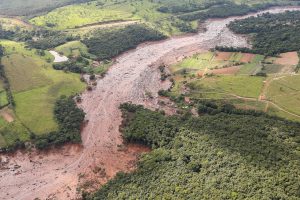Two years ago this week, the global mining industry felt the ground crumble beneath its feet. At the decommissioned Córrego do Feijão iron ore mine in Brazil, a tailings dam suddenly collapsed, unleashing a wall of toxic sludge that roared through the serene valleys around the city of Brumadinho.
Security cameras captured the disaster in stomach-churning detail, including the horrifying moment when the earthen dam burst. An estimated 270 people died, many buried alive by the sludge. The area’s rivers and ecosystems are likely to be polluted for generations. The former CEO of Vale, which owns the mine, faces homicide charges in a Brazilian court.
The risks of tailings ponds – where toxic waste from mines is stored behind large dams – had been laid bare.
The psychological shockwaves of the Córrego do Feijão collapse reached China, home to approximately 8,000 tailings facilities, the most in the world. In March of last year, the Chinese government announced new safety guidelines meant to stave off a similar disaster. They establish buffer zones with residential areas and major rivers and cap the height and number of dams permissible.
But they have one fatal flaw: They do not apply to Chinese-owned mines overseas. This creates a dangerous double standard. As Chinese mining companies pursue resources abroad, including in Southeast Asia, where they are a leading player, they risk causing another catastrophe on the scale of Brumadinho.
Our organizations have seen these risks up close. In Indonesia, we are supporting communities on the island of Sumatra whose land is threatened by a planned zinc mine and tailings facility. A Chinese-Indonesian joint venture, Dairi Prima Mineral, will extract the “world-class” zinc reserve and ship the ore to China, where it will be used to make cars, batteries, and galvanized steel for construction. The state-controlled mining company China Nonferrous Metal Industry’s Foreign Engineering and Construction Co., Ltd. is the majority shareholder in the joint venture and is calling the shots on the ground.
The project is extraordinarily risky. It is being developed in one of the most earthquake-prone regions in the world. The tailings dam will sit above the complex of faults and subductions that produced the 9.1-magnitude earthquake, the cause of the destructive December 2004 tsunami. The area is also prone to torrential rainfall and landslides, making the ground particularly unstable.
Richard Meehan, a Stanford University engineer who has studied dams for 40 years, sees a disaster waiting to happen. Another strong earthquake, which he said is “almost certain to occur,” could unleash more than 1 million tons of mud and toxic waste on the nearby village of Sopokomil, according to computer modeling he has done.
Sopokomil is located just 400 meters downhill from the planned tailings facility. That falls well short of the 1-kilometer residential buffer zone called for in the new Chinese safety guidelines. Moreover, geological data presented by the company is “misleading and wrong,” Meehan said. The company has drilled exploratory boreholes at the tailings site but failed to find a foundation strong enough to withstand an earthquake.
Dairi Prima Mineral has misled local people, many of them indigenous, who have the most to lose. The company has been evasive and disingenuous in explaining its plans, playing up the economic benefits while burying the safety risks, community members say.
Mistrust runs deep. “I don’t believe what the company tells us,” said Sugianto Hasugian, a 40-year-old farmer and father of three. “The tailings dam terrifies me. I’ve seen on the internet what happens when they collapse.”
The forest is also home to an incredible array of flora and fauna, including critically endangered orangutans. A dam collapse would also devastate this globally important biodiversity. Local leaders are calling for the mine to be cancelled unless it meets international safety standards.
These risks are borne not just by the project’s owners, but by the financiers, shareholders, and supply chains enabling it. An investigation conducted by our organizations revealed that the International Finance Corporation (IFC), part of the World Bank, is indirectly financing the mine. The IFC’s internal watchdog has accepted a complaint filed by local communities and will attempt to bring the company to the table to negotiate.
We also found that the company will seek project financing from Chinese banks, with the Bank of China and Industrial & Commercial Bank of China signaling their interest. The Wanxiang Group, a key buyer of China Nonferrous zinc, counts among its customers the world’s largest car brands, such as Volkswagen, Ford, and Toyota.
China Nonferrous’ shareholders also bear considerable risk in the event of a collapse. After the Brumadinho disaster, Vale’s shares lost a stunning $19 billion in market value. The company now faces a shareholder class-action lawsuit that could cost billions.
An investor-led tailings safety initiative, launched last year, is designed to mitigate the moral and financial risks borne by shareholders of mining companies. As a first step, the initiative asked companies to disclose basic information about their facilities. Neither China Nonferrous-connected entities nor its Indonesian joint-venture partner, Bumi Resources, have provided information to the initiative.
Globally, tailings facilities have a failure rate of 2 to 5 percent, according to dam expert Meehan. That risk far outlasts the life of a mine, with waste lingering for up to 10,000 years.
China’s new safety guidelines aim to mitigate that risk by addressing the “blind optimism” and lack of risk management control the government found in the country’s mining industry. But unless those guidelines are applied overseas, vulnerable communities like those in North Sumatra will be forced to live in the shadow of disaster for generations.
Tongam Panggabean is Executive Director of the Medan-based advocacy group Bakumsu.
Dustin Roasa is Research Director of Inclusive Development International.
































